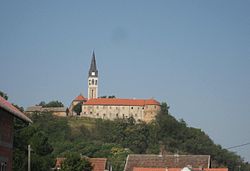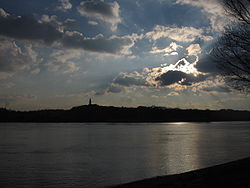- Ilok
-
Ilok View of Ilok from city's fortress 
Coat of armsLocation of Ilok in Croatia Coordinates: 45°13′N 19°23′E / 45.217°N 19.383°ECoordinates: 45°13′N 19°23′E / 45.217°N 19.383°E Country Croatia County Vukovar-Srijem County Government - Mayor Ivan Plazonić (HDZ) Elevation 135 m (443 ft) Population (2011)[1] - City 6,750 - Urban 5,036 Time zone CET (UTC+1) - Summer (DST) CEST (UTC+2) Postal code 32236 Area code(s) +385 32 Website http://www.ilok.info/ Ilok is the easternmost town and municipality in Croatia. Located in the Syrmia region, it lies on a hill overlooking the Danube river, which forms the border with the Vojvodina region of Serbia. The population of the town of Ilok is 5,036, while the total municipality population is 6,750 (census 2011).[1] The town is home to a Franciscan monastery and Ilok Castle, which is a popular day trip for domestic tourists.
Contents
Name
In Croatian, the town is known as Ilok, in German as Illok, in Hungarian as Újlak and in Turkish as Uyluk. In Hungarian language "Újlak" means "new dwelling or lodge".
Demographics
In 2011 census, the total population of Ilok was 6,750, in the following settlements:[1]
- Bapska, population 940
- Ilok, population 5,036
- Mohovo, population 236
- Šarengrad, population 524
Ilok is home to the largest Slovak minority in Croatia. Ethnic groups in the Ilok municipality (2001 census):[2]
History
The area of present-day Ilok was populated since the neolithic and Bronze Ages. The Romans settled there in the 1st or 2nd century and built Cucium, the first border fortification on the Danube. The Slavs settled here in the 6th century, and the Croats arrived here probably after the collapse of the second Avar Khanate. The area was later ruled by the Bulgarian Empire, until it was included into the medieval Kingdom of Hungary.
In 12th and 13th centuries the market-town of Ilok was mentioned in documents under various names (Iwnlak, Vilak, Vylok, Wyhok, Wylak). At the end of the 13th century, Hungarian kings gave the Vylak castrum to the powerful Csák noble family. In the 13th and 14th centuries, Ilok was a capital of the semi-independent medieval state of Upper Syrmia ruled by Ugrin Csák.
After 1354, the town of Ilok belonged to Nicholas and Paul Garay (in South Slavic references Gorjanski), and then to Nicholas Kont of Orahovica and his descendants, among which was his great-grandson Nicholas and the last member of the Iločki family - Laurence of Ilok. Nicholas of Ilok was the Ban of the "whole Slavonia" from 1457 to 1463, and his son, Laurence was a duke of Syrmia from 1477 to 1524.
Since 1526, the town was under Ottoman rule. During this time, it was mainly populated by Muslims. In 1566-9, Ilok had 238 Muslim and 27 Christian houses. In 1572, it had 386 Muslim, and 18 Christian houses. In 1669, the population of Ilok numbered 1,160 houses, and town possessed two mosques. In 1697, Habsburg army took Ilok from the Ottomans and Muslim population fled from the town.
During the Habsburg rule, Ilok belonged to the Kingdom of Slavonia, a Habsburg province that belonged to both, the Kingdom of Croatia, and the Kingdom of Hungary. Between 1849 and 1868, the Kingdom of Slavonia was completely separate Habsburg crownland, and in 1868 it was joined with the Kingdom of Croatia to form the Kingdom of Croatia-Slavonia.
In 1918, Ilok first became part of the State of Slovenes, Croats, and Serbs, and then part of the Kingdom of Serbs, Croats and Slovenes (later known as the Kingdom of Yugoslavia). Between 1939 and 1941 it belonged to the Banovina of Croatia, one of the provinces of the Kingdom. Between 1941 and 1944, it belonged to the Independent State of Croatia, and since 1945, it was part of the People's Republic of Croatia within new Socialist Yugoslavia.
On October 17, 1991 during the beginning of the Croatian war of independence, the Croats and other non-Serbs of Ilok fled as the Yugoslav National Army led by Serbs paramilitaries occupied the area, but spared it from destruction due to its rapid surrounding and occupation. Between 1991 and 1995, Ilok was part of the Republic of Serb Krajina. The area was peacefully reintegrated into Croatia in 1998, with the exception of island of Šarengrad on Danube, which is still under the control of Serbia.
Tourism
Ilok is a transit-tourist, port and border town on the Danube, known as the easternmost place in Croatia. The important cultural and historical heritage with Gothic churches being the most distinguished objects representing the borderline between the western and eastern art, as well as the relicts of Islamic architecture make Ilok a very interesting town of this part of Croatia.
Ilok is also the centre of the rich wine-growing region. The grape harvest of Ilok represents a traditional annual event in the town (end of September, beginning of October). The Ilok wines (Traminer, Burgundy, Grasevina) as well as the excellent Ilok cuisine are famous beyond the Croatian borders.
See also
- Vukovar-Srijem County
- Vojvodina
References
- ^ a b c "Census of Population, Households and Dwellings 2011, First Results by Settlements" (in Croatian and English) (HTML). Statistical Reports (Zagreb: Croatian Bureau of Statistics) (1441). June 2011. ISSN 1332-0297. http://www.dzs.hr/Eng/censuses/census2011/htm/E11_Zup26_1546.html. Retrieved 2011-09-10.
- ^ 2001 census for Vukovar-Srijem County (Croatian)
External links
- Official the tourist pages of the town of Ilok (Croatian) (English) (German)
- Wine route of Ilok (Croatian)
Subdivisions of Vukovar-Syrmia County Towns Municipalities Andrijaševci · Babina Greda · Bogdanovci · Borovo · Bošnjaci · Cerna · Drenovci · Gradište · Gunja · Ivankovo · Jarmina · Lovas · Markušica · Negoslavci · Nijemci · Nuštar · Privlaka · Stari Jankovci · Stari Mikanovci · Štitar · Tompojevci · Tordinci · Tovarnik · Trpinja · Vođinci · VrbanjaThe Danube Countries 
Cities Tributaries Islands List of crossings Categories:- Cities and towns in Croatia
- Populated places in Vukovar-Syrmia County
- Populated places on the Danube
- Places in Syrmia
- Croatia–Serbia border crossings
Wikimedia Foundation. 2010.






